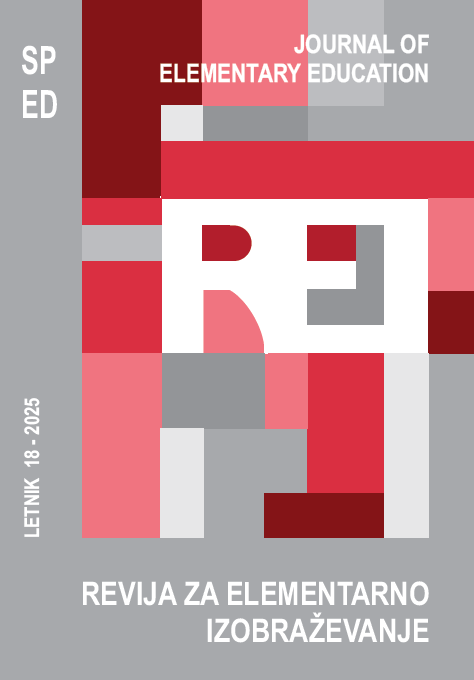Življenjski slog študentov v kontekstu gibalne dejavnosti, sedečega načina in akademskih dosežkov
DOI:
https://doi.org/10.18690/rei.5401Ključne besede:
gibalne dejavnosti, sedeče vedenje, akademski dosežki, študenti, kognitivna uspešnost.Povzetek
Raziskava je preučevala povezavo med gibalno dejavnostjo, sedečim vedenjem in akademskim uspehom med 243 študenti, starimi od 18 do 24 let. Gibalna dejavnost je bila ocenjena z vprašalnikom IPAQ-SF, sedeče vedenje z vprašalnikom SIT-Q-7d, akademski uspeh pa s povprečno oceno. Rezultati enosmerne ANOVE so pokazali, da višja raven gibalne dejavnosti ni nujno povezana z boljšimi akademskimi dosežki in da prekomerna predanost gibalni dejavnosti lahko zmanjša čas, ki je na voljo za učenje, in tako vpliva na akademsko uspešnost. Nasprotno pa lahko zmerno sedeče vedenje, zlasti ob vikendih, v kombinaciji z učnimi dejavnostmi, koristi akademski uspešnosti.
Literatura
Álvarez-Bueno, C., Pesce, C., Cavero-Redondo, I., Sánchez-López, M., Garrido-Miguel, M., and Martínez-Vizcaíno, V. (2017). Academic achievement and physical activity: A meta-analysis. Pediatrics, 140(6), e20171498.
Badrić, M., Prskalo, I., and Matijević, M. (2015). Primary school pupils' free time activities. Croatian Journal of Education, 17(2), 299–332.
Cohen, J. (1988). The effect size. Statistical power analysis for the behavioral sciences. Abingdon: Routledge, 77–83.
Daley, A. J., and Ryan, J. (2000). Academic performance and participation in physical activity by secondary school adolescents. Perceptual and Motor Skills, 91(2), 531–534.
Daramola, M. A., and Aribasoye, R. M. (2023). Effect of Physical Activity, Exercise and Sedentary Behaviour on Academic Performance of Students in Higher Institutions. European Journal of Theoretical and Applied Sciences, 1(6), 547-556.
Donnelly, J. E., Hillman, C. H., Castelli, D., Etnier, J. L., Lee, S., Tomporowski, P., ... and Szabo-Reed, A. N. (2016). Physical activity, fitness, cognitive function, and academic achievement in children: A systematic review. Medicine & Science in Sports & Exercise, 48(6), 1197–1222.
Erickson, K. I., Hillman, C., Stillman, C. M., Ballard, R. M., Bloodgood, B., Conroy, D. E., ... and Powell, K. E. (2019). Physical activity, cognition, and brain outcomes: A review of the 2018 physical activity guidelines. Medicine & Science in Sports & Exercise, 51(6), 1242–1251.
Hillman, C. H., Pontifex, M. B., Castelli, D. M., Khan, N. A., Raine, L. B., Scudder, M. R., ... and Kamijo, K. (2014). Effects of the FITKids randomized controlled trial on executive control and brain function. Pediatrics, 134(4), e1063–e1071.
Hunter, S., Leatherdale, S. T., and Carson, V. (2018). The 3‐year longitudinal impact of sedentary behavior on the academic achievement of secondary school students. Journal of School Health, 88(9), 660–668.
Kovalenko, A. (2024). Formation of healthy lifestyle of students by means of physical training. Scientific Journal of Polonia University, 62(1), 175–181.
Jančič, J., & Planinšec, . J. (2018). Primerjava športnih dejavnosti učencev iz Maribora in Novega Sada. Journal of Elementary Education, 11(4), 330-340. https://journals.um.si/index.php–/education/article/view/174
Lee, P. H., Macfarlane, D. J., Lam, T. H., and Stewart, S. M. (2011). Validity of the International Physical Activity Questionnaire Short Form (IPAQ-SF): A systematic review. International Journal of Behavioral Nutrition and Physical Activity, 8(1), 115.
Lipošek, S., Planinšec, J., Leskošek, B., and Pajtler, A. (2019). Physical activity of university students and its relation to physical fitness and academic success. Annales Kinesiologiae, 9(2).
Liu, T., and Taresh, S. (2024). The impact of sports participation on college students' learning outcomes: A mixed methods study based on multiple campuses. Journal of Ecohumanism, 3(7), 3649–3666.
Pandolfo, K., Minuzzi, T., Azambuja, C., and Dos Santos, D. (2017). Physical activity and academic performance in high school students. Revista Brasileira de Atividade Física & Saúde, 22(5), 486-492.
Prskalo, I. (2018). Kinesiology and Sustainable Development. Croatian Journal of Education = Hrvatski časopis za odgoj i obrazovanje, 20 (Sp. ed. 3), 321-327.
Sallis, J. F., and Owen, N. (2015). Ecological models of health behavior. In K. Glanz, B. K. Rimer, and K. Viswanath (eds.), Health behavior: Theory, research, and practice (5th ed., pp. 43-64). Jossey-Bass.
Salas-Gomez, D., Fernandez-Gorgojo, M., Pozueta, A., Diaz-Ceballos, I., Lamarain, M., Perez, C., ... and Sanchez-Juan, P. (2020). Physical activity is associated with better executive function in university students. Frontiers in Human Neuroscience, 14, 11.
Sánchez, J. A. O., del Pozo, J., Álvarez-Barbosa, F., and Alfonso-Rosa, R. M. (2024). Longitudinal analysis of the effect of sedentary behavior on body composition, physical fitness, and academic performance in preadolescents and adolescents. E-balonmano.com Journal Sports Science, 20(2), 197–206.
Sánchez-Oliva, D., Leech, R. M., Esteban-Cornejo, I., Cristi-Montero, C., Pérez-Bey, A., Cabanas-Sánchez, V., ... and Castro-Piñero, J. (2023). Sedentary behaviour profiles and longitudinal associations with academic performance in youth: The UP&DOWN study. Journal of Sports Sciences, 41(2), 181–189.
Suárez-Cano, L., Bernal-Ballén, A., and Briceño Martínez, J. J. (2023). A Multivariate Study for Determining the Relationship Between Physical Activity, Physical Fitness, and Academic Performance. Sportis. Scientific Journal of School Sport, Physical Education and Psychomotricity, 9(2), 284-301.
Syväoja, H. J., Tammelin, T. H., Ahonen, T., Kankaanpää, A., and Kantomaa, M. T. (2014). The associations of objectively measured physical activity and sedentary time with cognitive functions in school-aged children. PloS one, 9(7), e103559.
Tremblay, M. S., LeBlanc, A. G., Kho, M. E., Saunders, T. J., Larouche, R., Colley, R. C., ... and Gorber, S. C. (2011). Systematic review of sedentary behaviour and health indicators in school-aged children and youth. International Journal of Behavioral Nutrition and Physical Activity, 8, 1-22.
Vedøy, I. B., Skulberg, K. R., Anderssen, S. A., Tjomsland, H. E., and Thurston, M. (2021). Physical activity and academic achievement among Norwegian adolescents: Findings from a longitudinal study. Preventive Medicine Reports, 21, 101312.
Wijndaele, K., De Bourdeaudhuij, I., Godino, J. G., Lynch, B. M., Griffin, S. J., Westgate, K., and Brage, S. (2014). Reliability and validity of a domain-specific last 7-d sedentary time questionnaire. Medicine and Science in Sports and Exercise, 46(6), 1248-60.
World Health Organization. (2020). WHO guidelines on physical activity and sedentary behaviour. World Health Organization.
Yu, M., Han, X., Wang, X., and Guan, R. (2023). Effects of Physical Exercise on Executive Functions among College Students in China: Exploring the Influence of Exercise Intensity and Duration. Behavioral Sciences, 13(12), 987.
Prenosi
Objavljeno
Številka
Rubrika
Licenca
Avtorske pravice (c) 2025 Ivan Prskalo, Jurij Planinšec

To delo je licencirano pod Creative Commons Priznanje avtorstva 4.0 mednarodno licenco.
